
June 2008
Volume 12, Number 1
| Contents | | | TESL-EJ Top |
 |
June 2008
|
||
|
When I decided to write this article, Twitter was riding the crest of a wave sweeping the microblogosphere. Nevermind that till Twitter's release in 2006 there hadn't even been a microblogosphere. But this Internet niche has proven durable, compelling, mildly addictive even, and integral to the workflow of the most ostentatiously connected educators and knowledge workers. Twitter was an idea that converged with a need few even knew existed. Still today, many are saying "Who needs it? Why?" Others are saying "WE need it, bring it back!!"
What is Twitter? According to Wikipedia, http://en.wikipedia.org/wiki/Twitter (as it appeared June 25, 2008): "Twitter is a free social networking and micro-blogging service that allows users to send "updates" (or "tweets"; text-based posts, up to 140 characters long) to the Twitter web site, via the Twitter web site, short message service (SMS), instant messaging, or a third-party application such as Twitterrific or Facebook. Updates are displayed on the user's profile page and instantly delivered to other users who have signed up to receive them. The sender can restrict delivery to those in his or her circle of friends (delivery to everyone is the default). Users can receive updates via the Twitter website, instant messaging, SMS, RSS, email or through an application."
For the more graphically oriented, the Commoncraft series by Lee and Sachi LeFever includes a video explaining "Twitter in Plain English": http://uk.youtube.com/watch?v=ddO9idmax0o&NR=1. Twitter was rated number 19 on The PC World post "The 100 Best Products of 2008," edited by Mark Sullivan, May 26, 2008 http://www.pcworld.com/article/id,146161-page,12-c,electronics/article.html#.
That in a nutshell is the story of Twitter. Now to fill in some details: Twitter is currently (in this present nanosecond) the most popular of the genre of 'microblogging' tools that emulate SMS messaging but fall short of blogging by whatever you can say in a blog beyond a very short text message of 140 characters (the maximum permissible length of an SMS text message when sending 8 bit data). Coincidentally this happens to be a text-length that encourages brief and succinct responses to the question, "What are you doing right now?" But if that's as far as you've got with Twitter you're a long way from fully appreciating it. In fact, as with many other milestones in our lives, Twitter's aficionados can most likely recall the moment when they 'finally got' Twitter -- and many have documented these moments in a wiki set up by Alan Levine here: http://cogdoghouse.wikispaces.com/TwitterCycle .
I 'finally got' Twitter when I heard Jeff Utecht's presentation entitled “Online Professional Development,” podcast as part of the 2007 K-12 online conference: http://k12onlineconference.org/?p=205. Jeff recorded his presentation as a description of what he was doing at his computer in Shanghai while walking us through how he was using Skype and other social networking tools to connect with his professional network from there. So he was crafting his presentation as a live Skypecast, and he mentioned that he had just put a message out on Twitter inviting anyone online to Skype-in and discuss with him how they were using these tools themselves. A few minutes later, he had a bite, as someone responded to his tweet and spontaneously joined him in Skype. The presentation then became a conversation which illustrated how Jeff's network functioned in connecting him with other educators to further each other's professional development through taking advantage of such opportunities to learn from one another. That was when I decided to start using Twitter myself.
As a further illustration of how Twitter contributes to the conversational aspects of professional development, as I am writing this (everything in Twitter happens 'now') there has just appeared a tweet from Cristina Costa where she points her network to some reflections on her experiences with Twitter. In her posting "Are you twittering this?" on the Pontydysgu - Bridge to Learning blog, http://www.pontydysgu.org/2008/06/are-you-twittering-this, Cris says she at first "put twitter in my have-an-account-but-not-using-it-tool shelf. And it remained there for a while until Carla Arena and the Blogging 4 Educators team spiced up my curiosity about it once again. They were twittering and I started following them. I was fascinated by the amount of relevant information, bits of personal insights and also some trivial tweets that were arriving at my desktop in a twinkling of an eye. It was fun and most times relevant. I started seeing the point of it."
Another illustration of 'finally getting' Twitter comes from a post in the blog GNUosphere (http://gnuosphere.wordpress.com/2008/01/28/questioning-twitter/, no author mentioned) where the blogger questions the value of Twitter. The post has since attracted over two dozen comments, each of which addresses some aspect of what it means to 'get' Twitter. The post was of course "twittered" to attract so much attention. Here are some sample comments:
To 'get' Twitter, you have to have your finger on the pulse of what is pumping lifeblood through the Internet, and that is the people on it and how they come together, connect, and relate to one another in virtual learning networks (for seminal explanations of connectivism see George Siemens's reading list for his upcoming course on Connectivism and Connective Knowledge, http://ltc.umanitoba.ca:83/connectivism/?page_id=13; the course is free, and you can find out more by following gsiemens on Twitter).
I threw in the word learning just now to keep this article on the topic of this journal, but in fact the concept behind Twitter is applicable to almost any kind of virtual network. When people say what they are doing right now they might be feeding the baby or doing laundry, or more interestingly, "Just landed in Bangkok, hey the wireless works." Now let's put the word learning back in, and suppose that people in your network understand that there might be a low tolerance for things vacuous, and through their postings they genuinely seek to inform and engage one another. Then the postings might be, "See Flickr photos from a tour of Jokaydia," (e.g. http://flickr.com/groups/jokaydia/) or "Webcasting live right now on the Worldbridges network, http://edtechtalk.com," or "Reading a great new article by Marc Prensky" (e.g. Young Minds, Fast Times: The Twenty-First-Century Digital Learner - How tech-obsessed iKids would improve our schools, from the June 2008 issue of Edutopia, http://www.edutopia.org/ikid-digital-learner-technology-2008; announced through 'tweets' almost the moment it appeared).
Now suppose when you log on to Twitter you have a page full of postings like that staring back at you. Suppose you have cultivated a network of professional colleagues who reliably feed you URLs you might want to check out, and you've weeded out those who dwell on sagas in the laundromat. Let's further suppose that you might actually not mind hearing that someone whose writings you respect regularly goes online from the laundromat, or that someone else has an affinity for the brewer's art and intersperses a litany of pointers to interesting blog postings with mentions of tasting this or that amber fluid. One person I follow travels in west Texas on some tech-related work, the nature of which I haven't quite inferred, and tweets occasionally that he is in this bar or that restaurant, and implicitly invites anyone who is in the neighborhood to pop by and carry on the conversation over refreshments. I wonder if he gets any takers (and if so, I assume they would be like-minded people interested in the technology he blogs about), but that's not the point. What we're talking about here is just-in-time informal learning, social networking, low affective filters, a playground for knowledge workers where you can "follow" almost anyone you choose and enjoy his or her 140 character musings, often with a provocative URL to explore, from time to time, day to day, and even minute to minute. These gems of genuine interest are lodged in a matrix of emerging personalities that are themselves interesting. The result is an engaging mix of personality and professionalism, what Clive Thompson (2007) refers to in "How Twitter Creates a Social Sixth Sense" (Wired Magazine, http://www.wired.com/techbiz/media/magazine/15-07/st_thompson).
One of the most compelling aspects of this kind of connectivity is the immediacy. Once a network is established then people gradually get to know one another on it. They start to converse, to respond to and support one another. If I see on Twitter that someone has just begun streaming a presentation on http://www.ustream.tv/, and if I have a moment to learn something new right then (and the most successful users of this kind of networking are able to multitask or briefly postpone whatever else they are doing in order to avail themselves of such moments) then I will check out what's happening, and I seldom regret such decisions. I'll learn a new concept or try out a new tool, or I'll make a new contact. Working in this way doors will open to other doors I didn't know existed. After a while a lot of doors are open and I begin to feel more familiar with my virtual surroundings. On the flip side, productivity can suffer if one does not appropriately balance the lure of the constant feed-stream with the discipline to address tasks requiring focus. Or does it? Perhaps heightened productivity depends on taking time for such reflection and percolation of information, ideas, and insights.
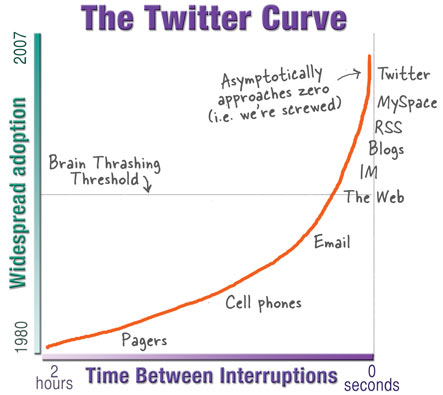
From Kathy Sierra's post from March 16, 2007, "Is Twitter TOO good?" in her blog Creating Passionate Users, http://headrush.typepad.com/creating_passionate_users/2007/03/is_twitter_too_.html
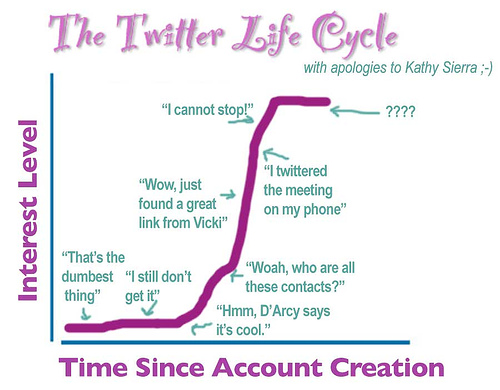
Kathy's whimsy prompted Alan Levine to created the knockoff graphic above in his posting "SPLJ 2.0" in his CogDogBlog April 26th, 2007, at: http://cogdogblog.com/2007/04/26/splj-20/
My own habit of using Twitter is to bring it up over coffee each morning and review the bustle in the Twittersphere while I was asleep. I soon have multiple tabs open on my browser where I have followed the most interesting links, and I then start tagging these at http://del.icio.us/vancestevens according to my own folksonomy (an idiosonomy?), which might in turn lead me to others who have tagged these sites as well. These links suggested by people in my distributed learning network contribute significantly to my professional development and to keeping me informed and abreast of my field. I can continue my learning by listening to podcasts in my car on my way to work in the morning, often suggested to me by people I follow in my Twitter network, and often recorded by the very people whose tweets I've been following over morning coffee.
The true value of Twitter is in this network. There are other microblogging platforms such as Jaiku <http://jaiku.com/>, Pownce <http://pownce.com/>, Plurk <http://www.plurk.com/>, and even Tumblr <http://www.tumblr.com/>. Tumblr is a different kind of microblogging platform to the others, which allows users to post (or microblog) a variety of media on the fly. For more on Tumblr (from the horse's mouth) there's an interview at EdTechTalk between Paul Allison and Tumblr founder David Karp, here: http://edtechtalk.com/node/3023. Plurk is more similar in concept to Twitter, though as with Tumblr, it lets you easily incorporate media in posts. It has an intriguing interface, lets you quickly add Plurk 'fans' from your Twitter followers list, and arrays posts on a time-line where you can pull-down any given one and have conversations by postings comments. Plurk awards users Karma points for effective social networking behaviors (e.g. posting, commenting, introducing others to Plurk) which can be exchanged for enhanced features such as the right to customize a user name. There's an amusing Bubbleshare slide show presenting telltale screen shots from Twitter and Plurk which reveal the less than ideal performance of both programs, at Vicky Davis's Cool Cat Teacher blog, "A photographic journey into Plurk: See for yourself before you jump the twittership," from June 26, 2008: http://coolcatteacher.blogspot.com/2008/06/photographic-journey-into-plurk-see-for.html. Like Twitter, Plurk is blocked over public Internet in the UAE, so I often use Pownce simply because it isn't. Pownce is a microblogging platform with a pleasant interface which is also media friendly and allows more than 140 characters, but neither Plurk nor Pownce have the network that Twitter does, for me.
Of course how one develops one's network, and where on prefers to do that -- whether with Twitter, Plurk, Jaiku, or Pownce (or some combination of these) -- would be particular to the individual, but there is a critical mass of participation of many users on Twitter that has driven it to the height of this genre of microblogging. It's the happening place where fusion constantly occurs. There might be several discos in town, but often there's only one that's hopping, or that has the magic, the dynamism, the appeal, and Twitter seems to have achieved the status of being where the action is (at present).
Due to its wide traction, Twitter users sometimes make news in the way they spread news; for example:
The simplicity of Twitter makes it amenable to mashup, or use of Twitter API's (application program interfaces) in combination with other tools or applications to enhance its capabilities beyond those envisaged by the program designers. One way of measuring not only the popularity but the versatility of a simple idea like Twitter is by looking at some of the third party software developed for it. For example, there are at least two ways of accessing Twitter through enhanced user-interfaces (see Kevin Chu's (2008) "Twitterific vs. Twhirl" in /dev/null/Kevin at http://blogs.sun.com/kevin/entry/twitterific_vs_twhirl - sic, the correct spelling is Twitterrific, with two r's).
Here are some compilations of Twitter resources, in no particular order:
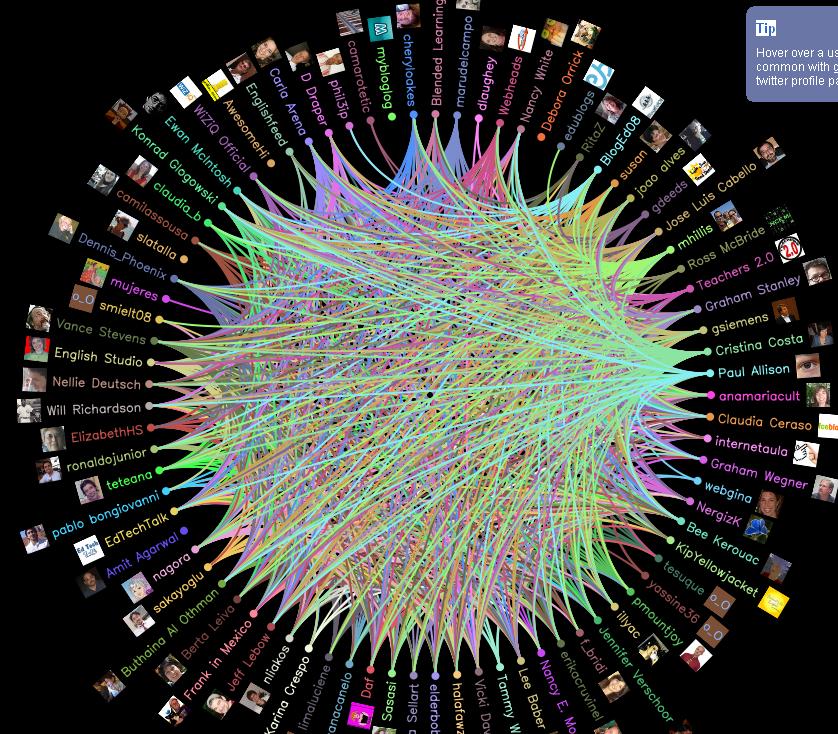
Gladys Baya's Tweetwheel graphic shows which of her followers are connected to one another, posted at: http://gladysbaya.edublogs.org/2008/05/19/my-tweetwheel-or-why-social-networking-matters/
Here are some examples of numerous mashups with Twitter (listed alphabetically):
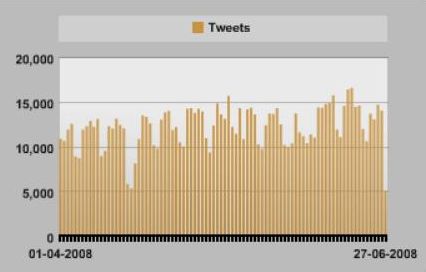
A Twitstat chart showing number of tweets registered on Twitter over the past 6 months
What does all this have to do with language teaching? Here are some posts and resources that have addressed pedagogical uses of Twitter recently:
There is one very disappointing, perhaps even fatal, flaw with Twitter, one that is seriously compromising its effectiveness as we speak, and that is its inability to scale. Google's great success was based largely on the ability of Sergei Brin and Larry Page to cobble together sufficient banks of computers that would keep their brainchild running as it not only cached the entire Internet but coped with the accelerating demands of exponentially expanding droves of appreciative users. But Google had a business model based in cleverly directed advertising that supported its maintenance of warehouses full of computers, which were farmed and expanded as needed to handle the load, whereas Twitter seems to not have the means to support its expansion. Limiting tweets to 140 characters kept it lean and simple but Twitter's database has since just this summer been overwhelmed by its burgeoning popularity. The service occasionally goes down, and whimsically displays a graphic of cherubic birds supporting a pastel whale on improbably stressed ribbons, which like Twitter itself, are perhaps a good representation of whatever it is that keeps Twitter on the air.
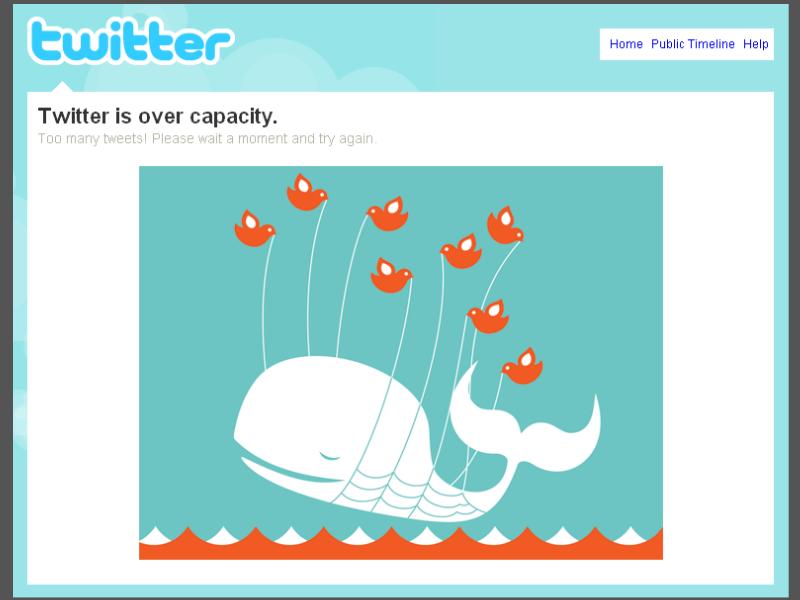
sigh ...
As I've been writing this article over the past month, when the service has been working it has not often supported its "OLDER" button. When this button is grayed out you can't access the database of tweets left by your network beyond a single page. If your network comprises a hundred or more colleagues, then this one page of tweets spans only the last few hours of their twitterings. The result is the most damaging thing of all, loss of cohesion of the network. Now I no longer have access to people who normally post when I sleep at night, or during times that I am away from the computer more than a few hours. And it's not just me. Microbloggers are complaining throughout the Twittersphere about this problem, an annoyance experienced by all.

Konrad Glogowski is using http://summize.com to help him keep up with his Twitter network
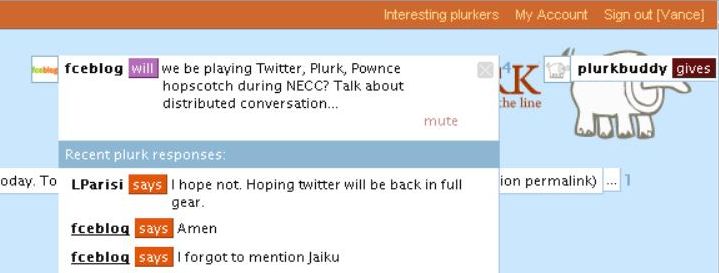
Last year's NECC conference had a vibrant Twitter back channel. This year, delegates are preparing their Plan B.
These problems with Twitter have been taking place just over the past month, and it is hoped that those managing Twitter will be able to revive the service and return it to its former stature. It is clear that Twitter has struck a chord among educators who enjoy and benefit from maintaining frequent symbiotic contact with so many others in their wide learning networks. As current king of the microblog mountain, Twitter has a valuable investment in its reputation for being able to reliably deliver that network on demand to its myriad loyal users. But this fan-base is slipping away as Twitter continues to frustrate those whose lifestyles and workflows now pivot so tenuously on Twitter. Although Twitter has been the tool of choice, like a trusty old car that is starting to give problems, if this tool no longer functions, people will soon opt for another. What people were actually enjoying was the new and effective way of interacting with their network. Now that the concept of microblogging through a constant interchange of SMS messages has proven so stimulating and popular, the herd could instinctively migrate to more stable pastures. Twitter could yet recover, but if not, it will not be long before another tool appears to take its place.
|
© Copyright rests with authors. Please cite TESL-EJ appropriately.
Editor's Note: The HTML version contains no page numbers. Please use the PDF version of this article for citations. |